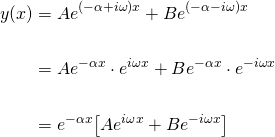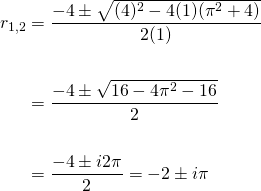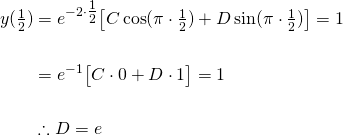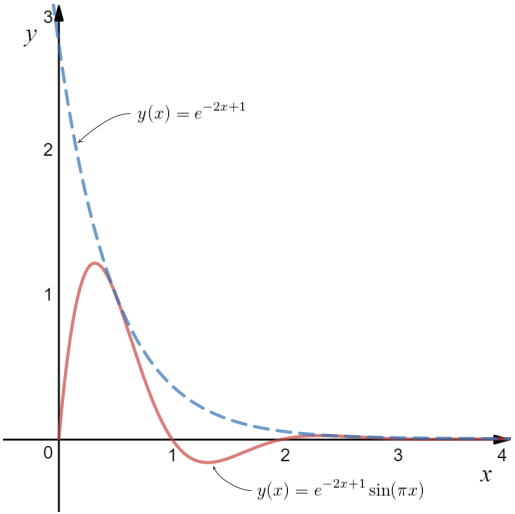Roots of Homogeneous Second Order ODE's and the Nature their Solutions
Continuing our second-order differential equations journey, let's have a look at some possible solutions to the homogeneous second order linear ODE...

Now, to recap, the characteristic equation corresponding to equation (1) is...

And the roots of equation (2) are...

Let's call the term inside the root sign Δ. Therefore...

The roots of the characteristic equation determines the nature of the solution, and types of roots we can obtain from the characteristic equation are determined by Δ. They are...
| Case I |  |
2 real and distinct roots |
| Case II |  |
1 real double root |
| Case III |  |
2 complex conjugate roots |
Let's have a look at an example of each case...
Case I: 2 real and distinct roots when Δ > 0
For Case I, the corresponding general solution is relatively straightforward as we simply get...

So let's do an example, and find the particular solution to the equation...

with initial conditions...

Firstly, the characteristic equation corresponding to (4) is...

And the roots to equation (5) are...

And thus the general solution to (4) is...

Now, applying the initial conditions, we have...

Solving (6) & (7) simultaneously, we get A = 6 and B = 4. And thus the particular solution is...

A graph of the solution is shown in Figure 1 below....

Figure 1. The particular solution to equation (4).
Case II: 1 real double root when Δ = 0
By the quadratic formula, when the discriminant Δ = 0, there is only 1 root...

So the solution is not simply...

...because we've only found 1 solution. To form a basis for 2nd Order ODE's, we need 2 linearly independent solutions.
To find the other solution, we need to use the reduction of order method discussed in the previous post.
By equation (4) of the previous post, we have...

and...

Therefore, the second solution that forms the basis is  . And thus the general solution is...
. And thus the general solution is...

Let's do an example that only has 1 real root. Take the equation...

with initial conditions...

The characteristic equation of (9) is...

And the only root is...

And thus the general solution is...

Now, applying the Initial Conditions, we have...

Therefore, the particular solution is...

Graphically, the solution is shown below in Figure 2...

Figure 2. The particular solution to equation (9)
Case III: Complex Conjugate Roots when Δ < 0
When the discriminant is negative, the roots of the characteristic equation are...

Thus we have 2 complex conjugate roots, where...

Thus the general solution is...

But how do we decipher the exponential functions of an imaginary number? Thankfully, we have the ingenious Euler's formula, where...

So substituting these into the general solution, we get...

Now, here's another neat trick. If A and B are complex conjugate pairs, that is, let...

...then the general solution becomes...

...where C and D are real, undetermined coefficients.
Now let's do one last example that has 2 complex conjugate roots...

...with initial conditions...

The characteristic equation of (12) is...

Thus the roots are...

And the general solution is...

Applying the first initial condition to (13), we have...

For the second initial conditon, we need the first derivative of (13), which is...

So applying the second initial condition, we have...

And thus, after all that the particular solution is...

Finally, Figure 3 below illustrates this particular solution...

Figure 3. The particular solution of equation (12)
Credits:
All equations in this tutorial were created with QuickLatex
All graphs were created with www.desmos.com/calculator
All example problems are my worked solutions from the textbook Advanced Engineering Mathemathics, 10th Edition, Kreyszig
First Order Differential Equations
- Introduction to Differential Equations - Part 1
- Differential Equations: Order and Linearity
- First-Order Differential Equations with Separable Variables - Example 1
- Separable Differential Equations - Example 2
- Modelling Exponential Growth of Bacteria with dy/dx = ky
- Modelling the Decay of Nuclear Medicine with dy/dx = -ky
- Exponential Decay: The mathematics behind your Camping Torch with dy/dx = -ky
- Mixing Salt & Water with Separable Differential Equations
- How Newton's Law of Cooling cools your Champagne
- The Logistic Model for Population Growth
- Predicting World Population Growth with the Logistic Model - Part 1
- Predicting World Population Growth with the Logistic Model - Part 2
- What's faster? Going up or Coming Down?
First order Non-linear Differential Equations
- There's a hole in my bucket! Let's turn it into a cool Math problem!
- The Calculus of Hot Chocolate Pouring!
- Foxes hunting Bunnies: Population Modelling with the Predator-Prey Equations
Second Order Differential Equations
- Introduction to Second Order Differential Equations
- Finding a Basis for solutions of Second Order ODE's
- Roots of Homogeneous Second Order ODE's and the Nature their Solutions
Please give me an Upvote and Resteem if you have found this tutorial helpful.
Please ask me a maths question by commenting below and I will try to help you in future posts.
I would really appreciate any small donation which will help me to help more math students of the world.
Tip me some DogeCoin: A4f3URZSWDoJCkWhVttbR3RjGHRSuLpaP3
Tip me at PayPal: https://paypal.me/MasterWu